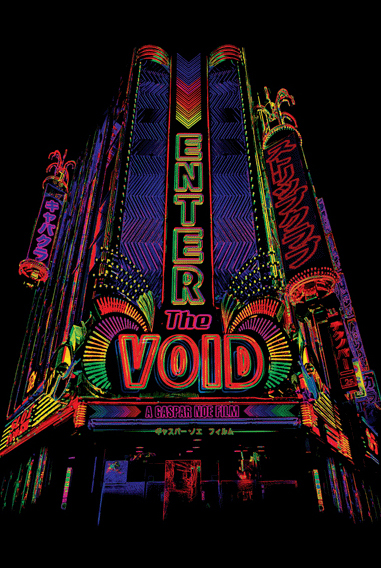Enter The Void, written and directed by Gaspar Noé, with Nathaniel Brown and Paz De La Huerta
The film opens with the credits over a short but visually exhausting series of flashing, psychedelic computer generated imagery, and the next 2 1/2 hours are made of intertwining sounds and images that blend into one another like an endless link through the keyholes of our minds, tailing the wanderings of brain synapses on acid or mushrooms. It’s filmed from beginning to end by a subjective camera, capturing a guy’s life as it unfolds in front of HIS eyes, and from inside HIS mind, even after his death…
 So yeah, it’s like a bad trip. The whole thing. Oscar (Nathaniel Brown) and his sister Linda (Paz De La Huerta) live in Tokyo. He deals drugs and she strip teases for a living. Oscar vowed to protect his sister forever but ends up being framed by a snitch and killed in a bar aptly named The Void. Ensue some very realistic images rendering sensations of life leaving the body. Not for the weak at heart.
So yeah, it’s like a bad trip. The whole thing. Oscar (Nathaniel Brown) and his sister Linda (Paz De La Huerta) live in Tokyo. He deals drugs and she strip teases for a living. Oscar vowed to protect his sister forever but ends up being framed by a snitch and killed in a bar aptly named The Void. Ensue some very realistic images rendering sensations of life leaving the body. Not for the weak at heart.
Right from the start, allusions to the Tibetan Book of the Dead accompany the viewer down the path to ultimate consciousness, right after death. We learn that the “newly dead” hovers for a bit, is in a state of nothingness and painlessness while still acutely aware of the realm of the living. He can no longer access this world but can decide to confront his greatest fears and come back in another form.
So as soon as Oscar dies, the camera shoots from overhead in a flowing, circular manner which gives the viewer a very unusual perspective, transporting from one space to another, through walls and obstacles, like an astral voyage.
This is a movie like a sensory experience, something between Tron, Altered States, and Being John Malkovitch, and with an environment of sound very reminiscent of Clockwork Orange and 2001: A Space Odessey. Somewhere between Tarantino and Kubrick, some qualify Gaspar Noé as a genius, if only a bit consumed by sex and death — which may be one and the same, depending on your perspective. Every line of dialog is uttered for a reason and will be served up again later to make the link from one frame to the other, in a thematic logic.

The rhythm created by the music is fluid, as are the images. Actually, what makes the movie so effective is the sound design (sound by Ken Yasumoto and music by Thomas Bangalter). Simple 2-note modulations on a minor chord make for an atmosphere of eerie, suspenseful anticipation, with Hichcockesque screeching that roams like a familiar, yet profoundly unsettling character.

As a matter of fact, the soundtrack is a character in its own right. It billows then softens to the comforting lull of Bach’s Orchestral Suite No. 3 in D major (the “Air” movement) when flashbacks and home movies take the viewer to Oscar’s and Linda’s childhood memories, then again explodes in calculated electronic mayhem where the action jumps suddenly to a brutal crash. The music is used to create and maintain constrast between respite and doom.
Thus we learn about the cataclysm in the lives of Oscar and Linda that would make them swear to never leave eachother. That particular scene is extremely jolting. It is repeated several times, each time more revealing of the trauma that bonds the siblings. This bond is the driving force of the film that Noé himself qualified as a “Psychedelic Melodrama,” a multi-layered tale about life, dying, guilt and responsibility after death, and coming back.

The final pulsating scene will last forever for some, leaving others to wonder what Gaspar was thinking of or what he was on. But the idea is that life comes full circle eventually and that Oscar finds the way to secure his own reincarnation. Let’s leave it at that…
Listen to a bit of the movie soundtrack here The Void Moan
SP

Wow….This is Great !!
LikeLike